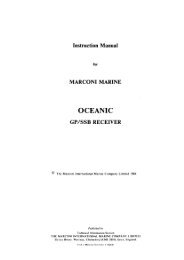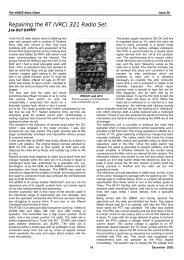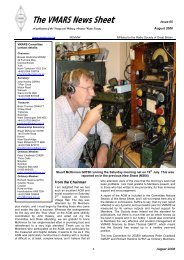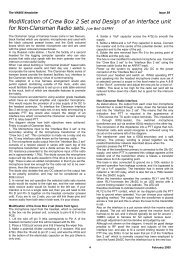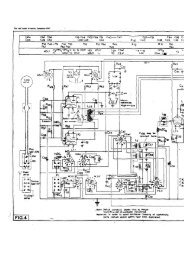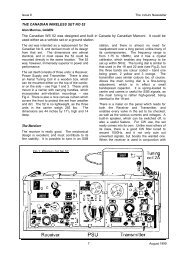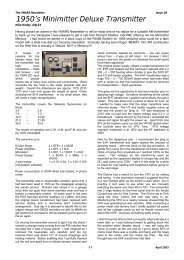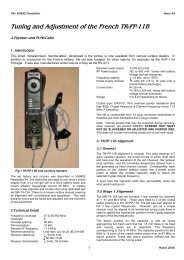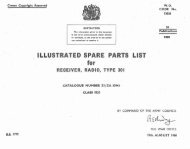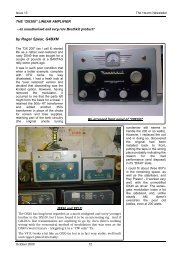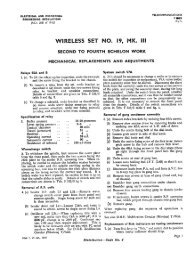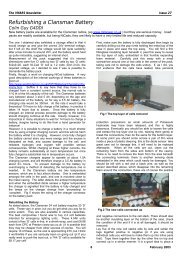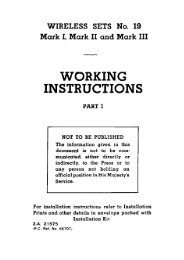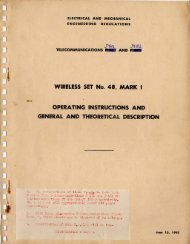2115_ Gee_MkII_Tropical.pdf - VMARSmanuals
2115_ Gee_MkII_Tropical.pdf - VMARSmanuals
2115_ Gee_MkII_Tropical.pdf - VMARSmanuals
Create successful ePaper yourself
Turn your PDF publications into a flip-book with our unique Google optimized e-Paper software.
----<br />
in the percentage modulation occurs in the<br />
stages V4 and V5, and in position " Z "<br />
of the anti-jamming switch an additional<br />
high pass filter consisting of the condensers<br />
and resistances C31, C32, R45 and R46 is<br />
included between the video frequency amplifier<br />
V7 and the cathode follower V8 to<br />
remove the last traces of ripple.<br />
51. The improvement obtained with this<br />
amplifier as compared with a straight<br />
receiver in the presence of either pure C.W.<br />
or pure very low frequency modulated C.W.<br />
is of the order of 1000 : 1.<br />
Power suppl-v unit.<br />
52. H.T. supply for the equipment is<br />
obtained from the transformer TI and the<br />
valve V9, operating as a normal full-wave<br />
rectifier. Smoothing is carried out by means<br />
of the chokes L9 and L 10. and the condensers<br />
C36 and C37. The valve V10 acts as a<br />
stabiliser against very low frequency jitter,<br />
which is generally present with the normal<br />
type of engine driven generator. Some of<br />
this ripple is fed on to the grid of V10<br />
and the gain is adjusted so that the ripple<br />
developed across the anode resistor R57<br />
exactly balances the ripple coming through<br />
direct from the pone: unit.<br />
55. Stabilised H.T. supply from the<br />
anode of V10 is fed to the indicating --<br />
-~ ~- unit<br />
~<br />
through the large 6-pin W plug. Unstabilised<br />
H.T. supply is fed to the receiver unit<br />
and to the R.F. unit.<br />
54. The negative rail supply is obtained<br />
from a tapping on the secondary of the<br />
transformer T1 and half-wave rectifier V11.<br />
The negative rail supply is obtained from<br />
the potential divider consisting of the<br />
resistors R53, R54 and R55. The heater<br />
supply for the receiver is obtained from a<br />
winding of the transformer TZ.<br />
Indicating unit. type 266.<br />
55. The circuit diagram of the Indicating<br />
unit, type 266 is illustrated in fig. 40.<br />
Crystal oscillator and divider unit.<br />
56. The pentode V12 is the crystal<br />
oscillator stage and is a VR91. The crystal<br />
has a fundamental frequency of 150 Kc/s<br />
and is connected in the grid circuit. The<br />
50ppF variable condenser, C42, is connected<br />
across the crystal to give line control of<br />
the frequency. The inductance L1 and<br />
condenser C43 form an impedance circuit<br />
in the Screen circuit to maintain the oscill-<br />
ation. The transformer T1 in the anode<br />
circuit has its secondary tuned to 150 kc/s,<br />
the crystal frequency. The output across<br />
the secondary winding of T1 is a sine wave,<br />
having an amplitude of at least 100V. ,<br />
peak to peak, and it is applied to the grid<br />
circuit of the valve V13 through a small<br />
condenser C50.<br />
57. The valve V13 acts as a " squegger "<br />
type of oscillator throush the transformer<br />
T2, which has two tightly coupled windings<br />
connected to the grid and anode circuits<br />
of the valve. The recurrence frequency of<br />
the "squegger " is locked by means of the<br />
150 kc/s sine wave applied to the grid of<br />
the valve V13, so that the output will consist<br />
of a series of sharp pulses having a recurrence<br />
frequency of 150 kc/s. These are fed to<br />
the next stage in the divider, V14. through a<br />
winding on transformer T3, which is connected<br />
in series with the anode circuit winding of<br />
the transformer T2.<br />
58. V14 is another " squegger " oscillator,<br />
having a similar arrangement to 1'13.<br />
The grid leak, R69, has its top end joined<br />
to the slider of the potentiometer, VR11.<br />
which forms part of a chain of resistors<br />
YR11 and R68 from the HT line to earth.<br />
The potential to which the grid leak is<br />
returned, is, therefore. adjustable by means<br />
of the potentiometer VRl I, and this serves<br />
to adjust the division ratio of the stage.<br />
59. The mode of operation of the<br />
dividers can best be understood by reference<br />
to fig. 35, which shows the waveforms<br />
obtained at various points in the divider<br />
circuit. (The waveforms are drawn as they<br />
would appear on an oscilloscope : during<br />
normal operation they are far sharper).<br />
Consider the valve V14 ; when the valve<br />
has completed one cycle of operation. the<br />
grid condenser is charged very negative.<br />
b<br />
thus cutting off the valve and preventing<br />
further oscillation. The grid condenser will<br />
now commence to discharge through the<br />
grid leak R69. The synchronising pulses<br />
will appear positive on the grid condenser<br />
as shown at (c) on fig. 35. Eventually<br />
one of the synchronising pulses will drive<br />
the grid sufficiently near zero bias to enabie<br />
the valve to oscillate.<br />
60. The first half cycle of oscillation<br />
will drive the grid more positive, but the<br />
potential across the grid condenser cannot<br />
rise much above earth potential as grid<br />
current will flow. The second half cycle



